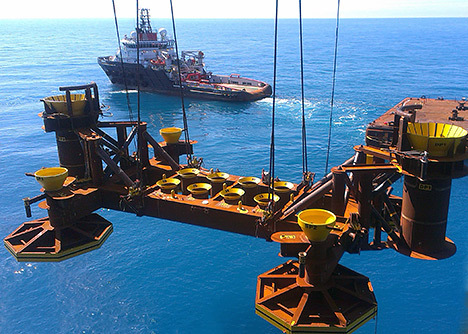
Brent crude entered a bear market, plunging below $45 a barrel for the first time since November as skepticism that a supply glut will ease worsens.
A decline in U.S. stockpiles wasn’t enough to dispel the pessimism that struck the market this month as American supplies remain stubbornly above their seasonal average and production keeps rising. The global benchmark closed more than 20 percent below the year’s peak settlement, meeting the common definition of a bear market. The same happened with West Texas Intermediate on Tuesday.
“There’s a sea of negativity,” said Maxwell Gold, director of investment strategy at ETF Securities LLC. “This is much more a story of sentiment weighing on the markets.”
Oil has returned to levels last seen before the Organization of Petroleum Exporting Countries and allies including Russia decided in November to cut production to drain a global glut. Relentless drilling in U.S. shale fields and renewed output from Libya are putting that effort in jeopardy.
Brent for August delivery settled $1.20 lower at $44.82, down 22 percent from its January peak. WTI fell 98 cents to close at $42.53 a barrel on the New York Mercantile Exchange, after dipping to the lowest since August.
American crude stockpiles fell by 2.45 million barrels last week and gasoline supplies slid by 577,999 barrels, according to an Energy Information Administration report Wednesday. Meanwhile, oil production rose to 9.35 million barrels a day, the highest level in almost two years.
“I don’t think one report by itself is enough to dispel the fears,” said Gene McGillian, manager for market research at Tradition Energy in Stamford, Connecticut. “I would be surprised if this is the beginning of a turnaround.”
A joint OPEC, non-OPEC committee concluded on Tuesday that the market won’t rebalance until the second quarter of 2018, beyond the current expiration of the group’s output agreement.
Potentially bullish factors failed to lift prices, including Tropical Storm Cindy halting service at a major oil terminal in the Gulf of Mexico, a shake-up in the Saudi royal family, and Iran’s Oil Minister Bijan Namdar Zanganeh saying on state radio that OPEC may decide to make deeper cuts.
“There is no bullish catalyst for oil to be seen at the moment and thus it is drifting lower,” said Bjarne Schieldrop, chief commodities analyst at SEB AB in Oslo. “It will be hard for Saudi and Russia to keep cutting production in the face of a strong rise in U.S. crude production and output in Libya.”
Oil-market news:
Saudi Arabia’s Deputy Crown Prince Mohammed bin Salman replaced his cousin as heir to the throne, a shock announcement that consolidates the 31-year-old leader’s power in the world’s biggest oil exporter. He is expected to continue the kingdom’s current oil policies. Short-term floating storage economics are “close to breakeven, assuming a VLCC hiring cost of $16,500,” JBC Energy said in a research note. Mexico is expected to increase gasoline imports from the U.S. with Pemex’s biggest refinery out of service for at least two weeks. Oil companies risk wasting $2.3 trillion of investments should demand peak in the next decade as the world works toward its goal of limiting global warming, according to a report from Carbon Tracker.
Recommended for you
